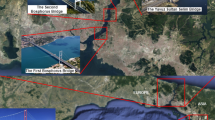Abstract
Railway transitions experience differential movements due to differences in track system stiffness, track damping characteristics, foundation type, ballast settlement from fouling and/or degradation, as well as fill and subgrade settlement. This differential movement is especially problematic for high speed rail infrastructure as the ‘bump’ at the transition is accentuated at high speeds. Identification of different factors contributing towards this differential movement, as well as development of design and maintenance strategies to mitigate the problem is imperative for the safe and economical operation of both freight and passenger rail networks. This paper presents the research framework and initial instrumentation details from an ongoing research effort at the University of Illinois at Urbana-Champaign. Three bridge approaches experiencing recurrent geometry problems were instrumented using multidepth deflectometers (MDDs) and strain gages to identify different factors contributing to the development of differential movements.
Similar content being viewed by others
References
Bilow, D., Li, D., 2005. Concrete Slab Track Test on the High Tonnage Loop at the Transportation Technology Center. AREMA Annual Conference, Chicago, Illinois.
Briaud, J., James, R., Hoffman, S., 1997. Settlement of Bridge Approaches (the Bump at the End of the Bridge). NCHRP Synthesis of Highway Practice 234, Transportation Research Board, Washington, DC.
Briaud, J., Nicks, N., Smith, B., 2006. The Bump at the End of the Railway Bridge. Research Report, Texas A&M University.
Chrismer, S., 1990. Track Surfacing with Conventional Tamping and Stone Injection. Association of American Railroads Research Report No. R-719, AAR Technical Center, Chicago.
DeBeer, M., Horak, E., Visser, A., 1989. The Multidepth Deflectometer (MDD) System for Determining the Effective Elastic Moduli of Pavement Layers. In: Bush-III, A.J., Baladi, G. (Eds.), Nondestructive Testing of Pavements and Backcalculation of Moduli, ASTM STP 1026, American Society for Testing and Materials, Philadelphia, p.70–89.
Dunnicliff, J., 1993. Geotechnical Instrumentation for Monitoring Field Performance. Wiley-Interscience Publications.
ERRI, 1999. State of the Art Report-Bridge Ends Embankment Structure Interaction. ERRI Project No. D230.1, Utrecht, the Netherlands.
Hyslip, J., Li, D., McDaniel, C., 2009. Railway Bridge Transition Case Study. 8th International Conference on Bearing Capacity of Roads, Railways, and Airfields, Champaign, Illinois.
Kerr, A., Moroney, B., 1993. Track Transition Problems and Remedies. Proceedings of the American Railway Engineering Association (AREA), 94:267–298.
Kerr, A., Bathurst, L., 2001. Upgrading Track Transitions for High-Speed Service. Report No. DOT/FRA/RDV-02/05, Federal Railroad Administration, US DOT.
Koch, K., 2007. Measurement of Coal Hopper Dynamic Load Environment 286,000-Pound Gross Rail Load Unit Train Service-August 2004 to May 2006. Research Report R-984, Transportation Technology Center Inc., Association of American Railroads.
Li, D., Davis, D., 2005. Transition of railroad bridge approaches. Journal of Geotechnical Engineering, 131(11):1392–1398.
McMichael, P., McNaughton, A., 2003. The Stoneblower-Delivering the Promise: Development, Testing and Operation of a New Track Maintenance System. TRB Annual Meeting, CD-ROM.
Nicks, J., 2009. The Bump at the End of the Railway Bridge. PhD Thesis, Texas A&M University, College Station, TX.
Plotkin, D., Davis, D., 2008. Bridge Approaches and Track Stiffness. Final Report, DOT/FRA/ORD-08-01, Federal Railroad Administration.
Read, D., Li, D., 2006. Design of Track Transitions. Transit Cooperative Research Program: Research Results Digest 79. Federal Transit Administration.
Rose, J., Anderson, J., 2006. Long-Term Performance of Asphalt Underlayment Trackbeds for Special Trackbed Applications. American Railway Engineering and Maintenance-of-Way Association. Annual Conference and Exposition, Louisville, KY.
Sasaoka, C., Davis, D., 2005. Implementing Track Transition Solutions for Heavy Axle Load Service. American Railway Engineering and Maintenance-of-Way Association. Annual Conference, Chicago, IL.
Sasaoka, C., Davis, D., Koch, K., Reiff, R., GeMeiner, W., 2005. Implementing Track Transition Solutions. Technology Digest TD-05-001, Transportation Technology Center Inc., Pueblo, CO.
Scullion, T., Briggs, R., Lytton, R., 1989. Using the Multidepth Deflectometer to Verify Modulus Backcalculation Procedures. In: Bush-III, A.J., Baladi, G., (Eds.), Nondestructive Testing of Pavements and Backcalculation of Moduli, ASTM STP 1026, American Society for Testing and Materials, p.90–101.
Selig, E., Li, D., 1994. Track modulus: Its meaning and factors influencing it. Transportation Research Record: Journal of the Transportation Research Board, (1470):47–54.
Stark, T., Olson, S., Long, J., 1995. Differential Movement at Embankment/Structure Interface. Research Report for the Illinois Department of Transportation.
Sussmann, T., Selig, E., 1998. Evaluation of Increased Axle Loading on Northeast Corridor Track Substructure. Test Report for Amtrak (National Railroad Passenger Corporation), Ernest T. Selig Inc., Hadley, MA.
Tutumluer, E., Stark, T.D., Mishra, D., Hyslip, J.P., 2012. Investigation and Mitigation of Differential Movement at Railway Transitions for US High Speed Passenger Rail and Joint Passenger/Freight Corridors. Proceedings of the ASME Joint Rail Conference.
White, D., Sritharan, S., Suleiman, M., Mekkawy, M., Chetlur, S., 2005. Identification of the Best Practices for Design, Construction, and Repair of Bridge Approaches. Final Report, Iowa DOT Project TR-481, Center for Transportation Research and Education, Iowa State University.
Zaman, M., Gopalasingam, A., Laguros, J., 1991. Consolidation settlement of bridge approach foundation. Journal of Geotechnical Engineering, 117(2):219–240.
Author information
Authors and Affiliations
Corresponding author
Rights and permissions
About this article
Cite this article
Mishra, D., Tutumluer, E., Stark, T.D. et al. Investigation of differential movement at railroad bridge approaches through geotechnical instrumentation. J. Zhejiang Univ. Sci. A 13, 814–824 (2012). https://doi.org/10.1631/jzus.A12ISGT7
Received:
Revised:
Published:
Issue Date:
DOI: https://doi.org/10.1631/jzus.A12ISGT7
Key words
- Track transition
- Differential movement
- Bridge approach
- Multidepth deflectometer (MDD)
- Bump at the end of the bridge
- Strain gage




